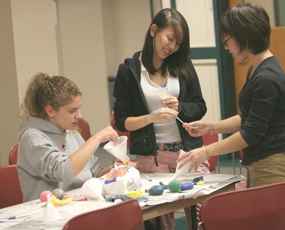Students relax, meditate at stress relief night

Emily Henkels, freshman in LAS, Dianna Xu and Rose Yaguchi, freshman in Business, fill balloons with flour to make stress balls during Avalanche´s Rest and Relaxation event held in Peabody Tunnels on Saturday. In light of all the mess, “It´s Adam Babcock
November 14, 2005
The importance of breathing was the recurring theme on Saturday night when students attended Rest and Relaxation, an event held by Avalanche, a residence hall organization that promotes drug-free activities, and the McKinley Health Center in the Peabody Residence Hall tunnels.
The event offered students the opportunity to relax and to learn to better cope with stress.
The warm lighting was dimmed in the small, carpeted room while students sat in red plastic chairs around the room. The students appeared comfortable in their sweatpants, jeans and t-shirts. Sneakers and sandals were scattered on the floor.
As part of Community Health 340, Max Kramer, junior in Communications, and Josh Zadikoff, junior in ACES, led the group through relaxation techniques. Kramer and Zadikoff work with McKinley to provide these relaxation events when they are requested.
They taught a series of relaxation techniques such as, Progressive Muscle Relaxation, Guided Imagery, Massage and Deep Breathing. Progressive Muscle Relaxation helps the body respond when muscles are tense. One can tense and relax separate body parts, such as the jaw, the forehead, the toes, or the calf muscles. With the Guided Imagery technique, one visualizes a special place to retreat to for relaxation guidance.
Get The Daily Illini in your inbox!
Kramer and Zadikoff, also emphasized the importance of deep breathing when attempting to relax. They pointed out the stomach should rise when one inhales, not the chest.
The students traded massages with a partner, using the techniques provided by the instructors. Students massaged each other’s shoulders and back, making sure to keep pressure off the spine. Massage can help one relax by increasing blood flow to tension areas, which relaxes muscles and removes build-up of waste products caused by tension, according to the McKinley tip sheet. These waste products are what can make the areas hurt.
“Brad’s hoping the massaging will help him with the ladies,” Emily Henkels, freshman in LAS, said about her friend Brad Herschler.
Herschler, freshman in Engineering, said he came to the event because his friends were going.
He said “homework, projects, exams, studying and no sleep,” are what stresses him. On average, Herschler gets about five-and-a-half hours of sleep each night.
“I’m more awake, because I came in tired,” Herschler said after the relaxation technique segment.
When Henkels stresses out, she either destroys a feather pillow or just tries to forget the offending thoughts in order to get through the day.
David Durham, senior in Engineering, taught the yoga portion of the evening. Aided by a book on yoga techniques and positions, he demonstrated while teaching a small routine. He began and ended with the Corpse pose, where one lays on his or her back with arms to the side and legs two to three feet apart. There was some giggling as students tried to spread their legs on the small floor space without hitting other legs, but as they got settled and closed their eyes, silence cut through the room.
“Breathe in … breathe out,” Durham said.
He led students through the Cobra pose, the Tree position, and the Bow position. Each position was held for about 15 seconds and repeated after a brief rest. Occasionally, the cracking of joints could be heard. When students attempted the Tree position, some had balancing issues while standing on one leg, and more giggling cut through the silence. During the Bow position, where a person lies on her stomach and grabs her ankles, one girl’s glasses were tilted on her face, and she tried to fix them with the floor.
They ended with the Corpse position, as Durham instructed the group to concentrate on their breathing.
“Feel your body sinking into the floor,” he said. “Move through your body, concentrate on each part and relaxing it.” He began with the toes, and slowly led the participants’ concentration upwards through the legs, abdomen, the arms and fingers and even individual parts of the face.
“You’re a stone, sinking into the ground,” Durham said.
The slow breathing was masked by the sounds of the air ventilation system in the background.
Even though this is the first time Durham has done yoga in about a year, he likes practicing yoga in the morning, for 20-30 minutes.
“It’s nice to get up to,” he said.
When he’s not teaching yoga, Durham regrets coming back from the deep relaxation, but it’s a must when instructing.
“If I don’t come back, people start falling asleep, or I fall asleep,” he said.
After yoga, participants moved to a brightly lit room to make stress balls. These could be used to relax discretely in tense situations.
“This is really stressful,” Henkels said laughing as she spent time tapping flour through a funnel into a balloon.






